technical specifications FIAT STILO 2006 1.G Owners Manual
[x] Cancel search | Manufacturer: FIAT, Model Year: 2006, Model line: STILO, Model: FIAT STILO 2006 1.GPages: 274, PDF Size: 4.76 MB
Page 145 of 274

144
WARNING
LIGHTS AND
MESSAGES
IN AN
EMERGENCY
CAR
MAINTENANCE
TECHNICAL
SPECIFICATIONS
INDEX
DASHBOARD
AND CONTROLS
SAFETY
DEVICES
CORRECT USE
OF THE CAR
IMPORTANT NOTES
❒With the car stopped and a gear en-
gaged always keep the brake pedal
pressed until deciding to move off;
❒during prolonged halts with the engine
running it is advisable to keep the gear-
box in neutral;
❒when the car is parked facing uphill, do
not use the moving off manoeuvre to
keep the car still; use the brake pedal
and press the accelerator pedal only
when the deciding to move off;
❒use second gear (2) only when more
control is needed for moving off ma-
noeuvres at low speed;
❒if, in reverse gear, first (1) gear is en-
gaged or vice versa, shift gear only
when the car is stopped completely and
with the brake pedal pressed.Though highly inadvisable, if when travel-
ling downhill for some unexpected reason
the car is set to neutral (N), when the en-
gagement of a gear is requested, the sys-
tem automatically engages the best gear in
relation to the speed of the car to allow
the correct transmission of torque to the
wheels.
When travelling downhill with a gear en-
gaged and the accelerator released (if the
car is moving), beyond a pre-established
speed, the system engages the clutch au-
tomatically to give the car adequate engine
braking.GEARSHIFTING
Through lever
Gearshifting takes place through the con-
trol lever A-fig. 8, which is of the float-
ing type with a “single central stable po-
sition”. It is possible to request an in-
crease/decrease of the gear ratio engaged
and/or reverse gear engagement (R) or
neutral (N).
To request gearshifting proceed as follows
fig. 9:
❒shift upwards (+) push the lever for-
wards. If the system is in neutral (N) or
in reverse (R) moving the lever for-
wards causes the engagement of first
gear (1);
❒to shift downwards (-) push the lever
backwards.
fig. 8F0C00105mfig. 9F0C0184m
Page 146 of 274
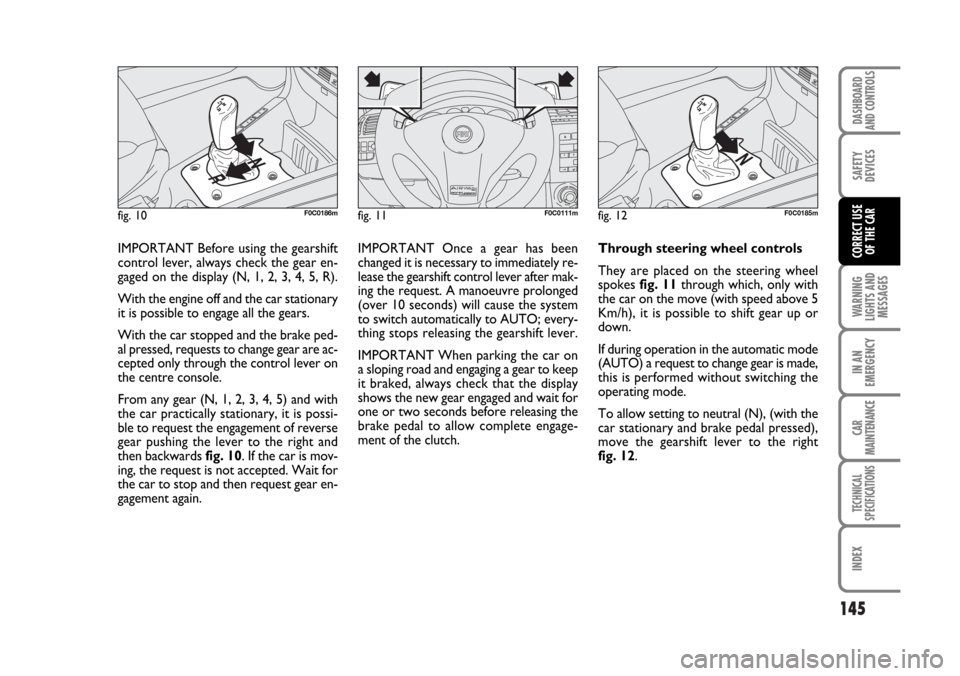
145
WARNING
LIGHTS AND
MESSAGES
IN AN
EMERGENCY
CAR
MAINTENANCE
TECHNICAL
SPECIFICATIONS
INDEX
DASHBOARD
AND CONTROLS
SAFETY
DEVICES
CORRECT USE
OF THE CARIMPORTANT Before using the gearshift
control lever, always check the gear en-
gaged on the display (N, 1, 2, 3, 4, 5, R).
With the engine off and the car stationary
it is possible to engage all the gears.
With the car stopped and the brake ped-
al pressed, requests to change gear are ac-
cepted only through the control lever on
the centre console.
From any gear (N, 1, 2, 3, 4, 5) and with
the car practically stationary, it is possi-
ble to request the engagement of reverse
gear pushing the lever to the right and
then backwards fig. 10. If the car is mov-
ing, the request is not accepted. Wait for
the car to stop and then request gear en-
gagement again.IMPORTANT Once a gear has been
changed it is necessary to immediately re-
lease the gearshift control lever after mak-
ing the request. A manoeuvre prolonged
(over 10 seconds) will cause the system
to switch automatically to AUTO; every-
thing stops releasing the gearshift lever.
IMPORTANT When parking the car on
a sloping road and engaging a gear to keep
it braked, always check that the display
shows the new gear engaged and wait for
one or two seconds before releasing the
brake pedal to allow complete engage-
ment of the clutch.Through steering wheel controls
They are placed on the steering wheel
spokes fig. 11through which, only with
the car on the move (with speed above 5
Km/h), it is possible to shift gear up or
down.
If during operation in the automatic mode
(AUTO) a request to change gear is made,
this is performed without switching the
operating mode.
To allow setting to neutral (N), (with the
car stationary and brake pedal pressed),
move the gearshift lever to the right
fig. 12.
fig. 10F0C0186mfig. 11F0C0111mfig. 12F0C0185m
Page 147 of 274
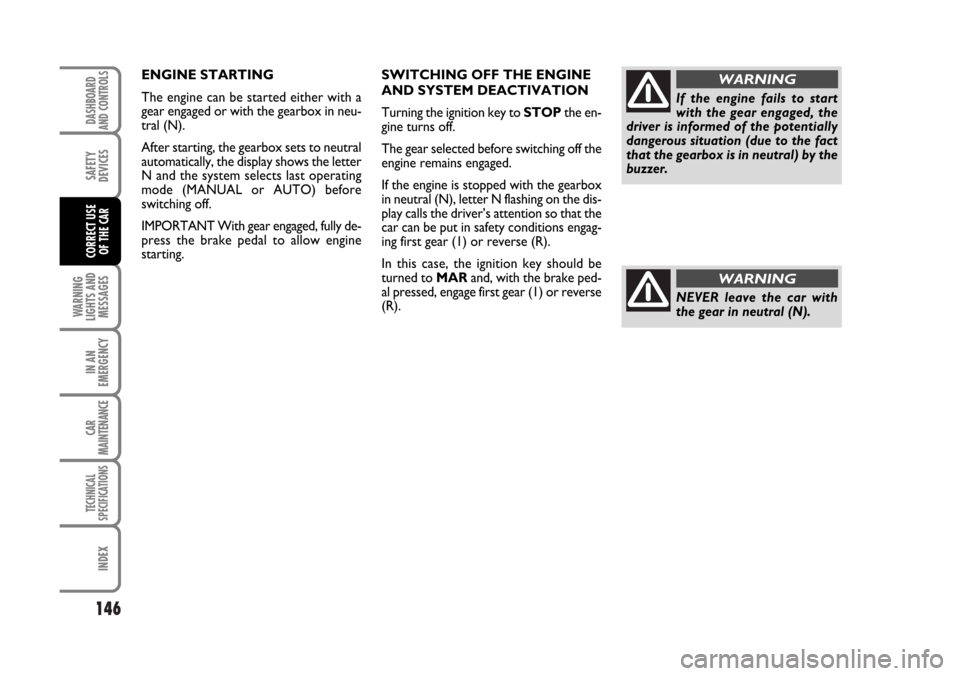
146
WARNING
LIGHTS AND
MESSAGES
IN AN
EMERGENCY
CAR
MAINTENANCE
TECHNICAL
SPECIFICATIONS
INDEX
DASHBOARD
AND CONTROLS
SAFETY
DEVICES
CORRECT USE
OF THE CAR
ENGINE STARTING
The engine can be started either with a
gear engaged or with the gearbox in neu-
tral (N).
After starting, the gearbox sets to neutral
automatically, the display shows the letter
N and the system selects last operating
mode (MANUAL or AUTO) before
switching off.
IMPORTANT With gear engaged, fully de-
press the brake pedal to allow engine
starting.SWITCHING OFF THE ENGINE
AND SYSTEM DEACTIVATION
Turning the ignition key to STOPthe en-
gine turns off.
The gear selected before switching off the
engine remains engaged.
If the engine is stopped with the gearbox
in neutral (N), letter N flashing on the dis-
play calls the driver’s attention so that the
car can be put in safety conditions engag-
ing first gear (1) or reverse (R).
In this case, the ignition key should be
turned to MARand, with the brake ped-
al pressed, engage first gear (1) or reverse
(R).
If the engine fails to start
with the gear engaged, the
driver is informed of the potentially
dangerous situation (due to the fact
that the gearbox is in neutral) by the
buzzer.
WARNING
NEVER leave the car with
the gear in neutral (N).
WARNING
Page 148 of 274
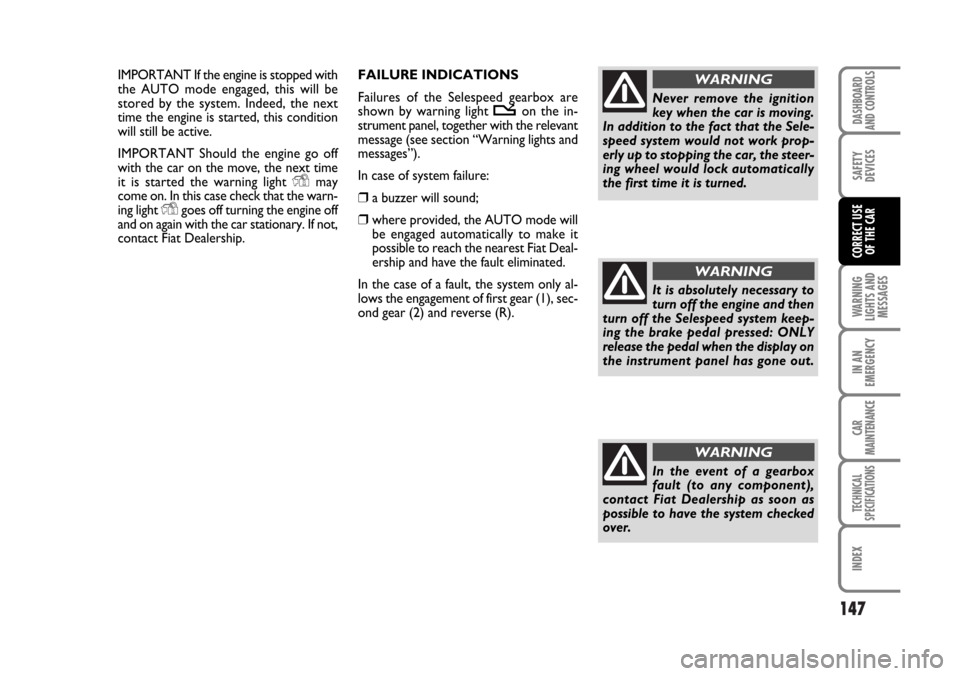
147
WARNING
LIGHTS AND
MESSAGES
IN AN
EMERGENCY
CAR
MAINTENANCE
TECHNICAL
SPECIFICATIONS
INDEX
DASHBOARD
AND CONTROLS
SAFETY
DEVICES
CORRECT USE
OF THE CAR
FAILURE INDICATIONS
Failures of the Selespeed gearbox are
shown by warning light
ton the in-
strument panel, together with the relevant
message (see section “Warning lights and
messages”).
In case of system failure:
❒a buzzer will sound;
❒where provided, the AUTO mode will
be engaged automatically to make it
possible to reach the nearest Fiat Deal-
ership and have the fault eliminated.
In the case of a fault, the system only al-
lows the engagement of first gear (1), sec-
ond gear (2) and reverse (R). IMPORTANT If the engine is stopped with
the AUTO mode engaged, this will be
stored by the system. Indeed, the next
time the engine is started, this condition
will still be active.
IMPORTANT Should the engine go off
with the car on the move, the next time
it is started the warning light
Ymay
come on. In this case check that the warn-
ing light
Ygoes off turning the engine off
and on again with the car stationary. If not,
contact Fiat Dealership.
Never remove the ignition
key when the car is moving.
In addition to the fact that the Sele-
speed system would not work prop-
erly up to stopping the car, the steer-
ing wheel would lock automatically
the first time it is turned.
WARNING
It is absolutely necessary to
turn off the engine and then
turn off the Selespeed system keep-
ing the brake pedal pressed: ONLY
release the pedal when the display on
the instrument panel has gone out.
WARNING
In the event of a gearbox
fault (to any component),
contact Fiat Dealership as soon as
possible to have the system checked
over.
WARNING
Page 149 of 274
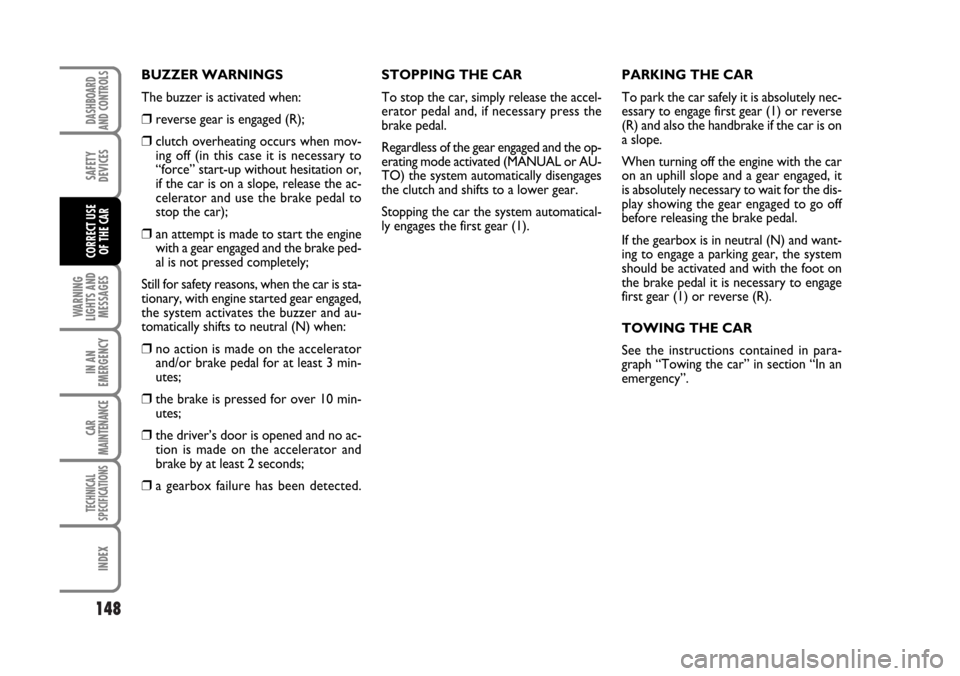
148
WARNING
LIGHTS AND
MESSAGES
IN AN
EMERGENCY
CAR
MAINTENANCE
TECHNICAL
SPECIFICATIONS
INDEX
DASHBOARD
AND CONTROLS
SAFETY
DEVICES
CORRECT USE
OF THE CAR
STOPPING THE CAR
To stop the car, simply release the accel-
erator pedal and, if necessary press the
brake pedal.
Regardless of the gear engaged and the op-
erating mode activated (MANUAL or AU-
TO) the system automatically disengages
the clutch and shifts to a lower gear.
Stopping the car the system automatical-
ly engages the first gear (1).PARKING THE CAR
To park the car safely it is absolutely nec-
essary to engage first gear (1) or reverse
(R) and also the handbrake if the car is on
a slope.
When turning off the engine with the car
on an uphill slope and a gear engaged, it
is absolutely necessary to wait for the dis-
play showing the gear engaged to go off
before releasing the brake pedal.
If the gearbox is in neutral (N) and want-
ing to engage a parking gear, the system
should be activated and with the foot on
the brake pedal it is necessary to engage
first gear (1) or reverse (R).
TOWING THE CAR
See the instructions contained in para-
graph “Towing the car” in section “In an
emergency”. BUZZER WARNINGS
The buzzer is activated when:
❒reverse gear is engaged (R);
❒clutch overheating occurs when mov-
ing off (in this case it is necessary to
“force” start-up without hesitation or,
if the car is on a slope, release the ac-
celerator and use the brake pedal to
stop the car);
❒an attempt is made to start the engine
with a gear engaged and the brake ped-
al is not pressed completely;
Still for safety reasons, when the car is sta-
tionary, with engine started gear engaged,
the system activates the buzzer and au-
tomatically shifts to neutral (N) when:
❒no action is made on the accelerator
and/or brake pedal for at least 3 min-
utes;
❒the brake is pressed for over 10 min-
utes;
❒the driver’s door is opened and no ac-
tion is made on the accelerator and
brake by at least 2 seconds;
❒a gearbox failure has been detected.
Page 150 of 274

149
WARNING
LIGHTS AND
MESSAGES
IN AN
EMERGENCY
CAR
MAINTENANCE
TECHNICAL
SPECIFICATIONS
INDEX
DASHBOARD
AND CONTROLS
SAFETY
DEVICES
CORRECT USE
OF THE CAR
CONTAINING
RUNNING COSTS
Here are some suggestions which may
help you to keep the running costs of your
car down and lower the amount of toxic
emissions released into the atmosphere.
GENERAL CONSIDERATIONS
Car maintenance
Have checks and adjustments carried out
in accordance with the “Service schedule”.
Tyres
Check the pressure of the tyres routine-
ly at an interval of no more than 4 weeks:
if the pressure is too low, consumption
levels increase as resistance to rolling is
higher.
Unnecessary loads
Do not travel with too much luggage
stowed in the boot. The weight of the car
(especially when driving in town) and its
trim greatly affects consumption and sta-
bility.Roof rack/ski rack
Remove the roof rack or the ski rack from
the roof as soon as they are no longer
used. These accessories lower air pene-
tration and adversely affect consumption
levels. When needing to carry particular-
ly voluminous objects, preferably use a
trailer.
Electric devices
Use electric devices only for the amount
of time needed. Rear heated window, ad-
ditional headlights, windscreen wipers and
heater fan need a considerable amount of
energy, therefore increasing the require-
ment of current increases fuel consump-
tion (up to +25% in the urban cycle).Climate control
The air conditioner is an additional load
which greatly affects the engine leading to
higher consumption (on average up to
+20%). When the temperature outside
the car permits it, use the air vents where
possible.
Spoilers
The use of non-certified aerodynamic
items may adversely affect air drag and
consumption levels.
Page 151 of 274
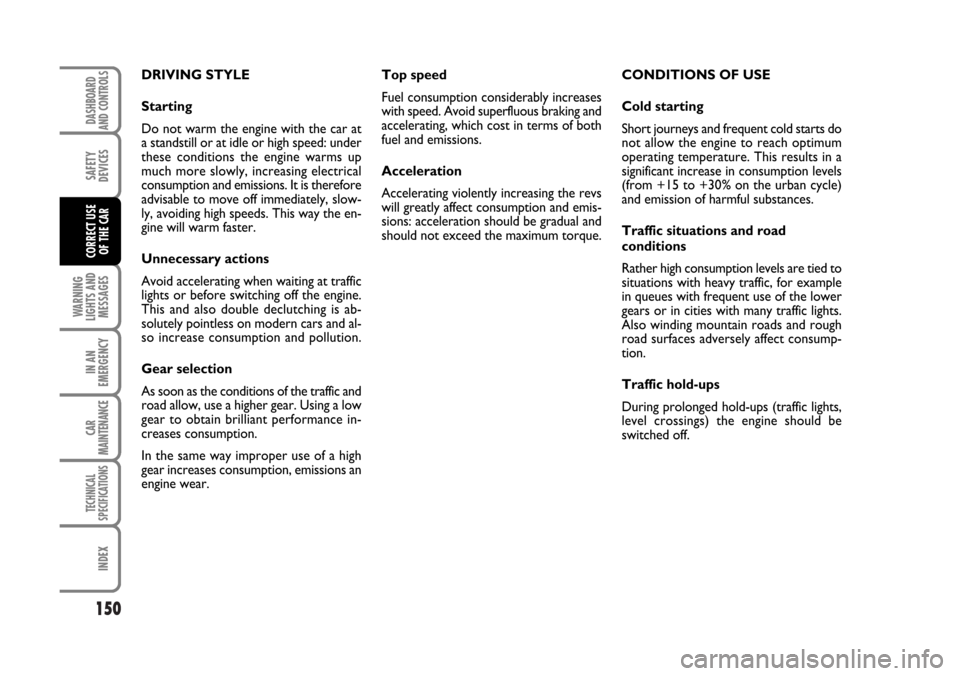
150
WARNING
LIGHTS AND
MESSAGES
IN AN
EMERGENCY
CAR
MAINTENANCE
TECHNICAL
SPECIFICATIONS
INDEX
DASHBOARD
AND CONTROLS
SAFETY
DEVICES
CORRECT USE
OF THE CAR
Top speed
Fuel consumption considerably increases
with speed. Avoid superfluous braking and
accelerating, which cost in terms of both
fuel and emissions.
Acceleration
Accelerating violently increasing the revs
will greatly affect consumption and emis-
sions: acceleration should be gradual and
should not exceed the maximum torque.CONDITIONS OF USE
Cold starting
Short journeys and frequent cold starts do
not allow the engine to reach optimum
operating temperature. This results in a
significant increase in consumption levels
(from +15 to +30% on the urban cycle)
and emission of harmful substances.
Traffic situations and road
conditions
Rather high consumption levels are tied to
situations with heavy traffic, for example
in queues with frequent use of the lower
gears or in cities with many traffic lights.
Also winding mountain roads and rough
road surfaces adversely affect consump-
tion.
Traffic hold-ups
During prolonged hold-ups (traffic lights,
level crossings) the engine should be
switched off. DRIVING STYLE
Starting
Do not warm the engine with the car at
a standstill or at idle or high speed: under
these conditions the engine warms up
much more slowly, increasing electrical
consumption and emissions. It is therefore
advisable to move off immediately, slow-
ly, avoiding high speeds. This way the en-
gine will warm faster.
Unnecessary actions
Avoid accelerating when waiting at traffic
lights or before switching off the engine.
This and also double declutching is ab-
solutely pointless on modern cars and al-
so increase consumption and pollution.
Gear selection
As soon as the conditions of the traffic and
road allow, use a higher gear. Using a low
gear to obtain brilliant performance in-
creases consumption.
In the same way improper use of a high
gear increases consumption, emissions an
engine wear.
Page 152 of 274
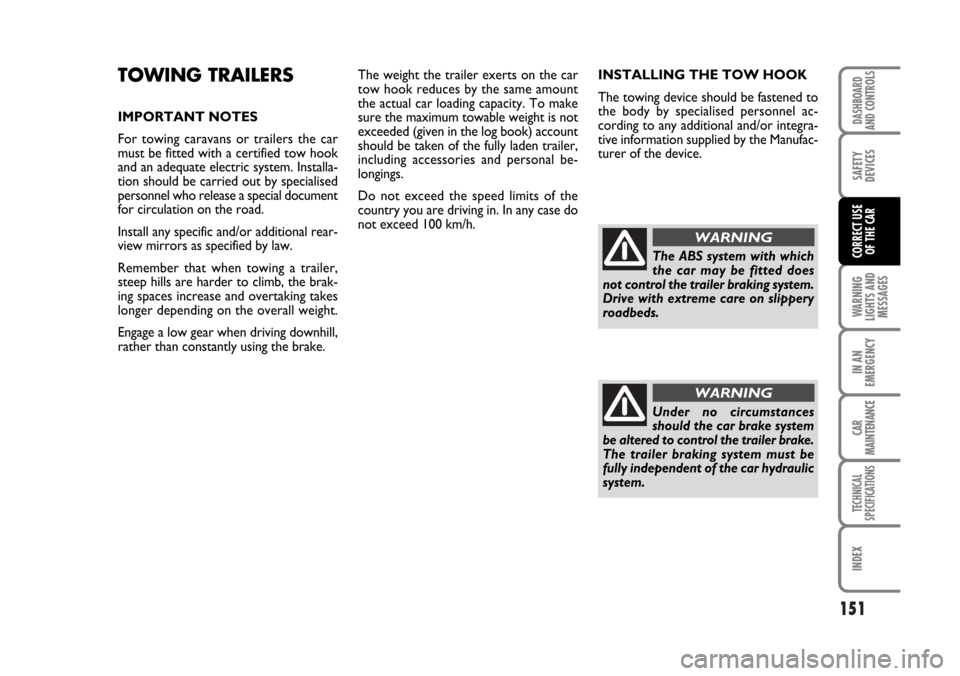
151
WARNING
LIGHTS AND
MESSAGES
IN AN
EMERGENCY
CAR
MAINTENANCE
TECHNICAL
SPECIFICATIONS
INDEX
DASHBOARD
AND CONTROLS
SAFETY
DEVICES
CORRECT USE
OF THE CAR
TOWING TRAILERS
IMPORTANT NOTES
For towing caravans or trailers the car
must be fitted with a certified tow hook
and an adequate electric system. Installa-
tion should be carried out by specialised
personnel who release a special document
for circulation on the road.
Install any specific and/or additional rear-
view mirrors as specified by law.
Remember that when towing a trailer,
steep hills are harder to climb, the brak-
ing spaces increase and overtaking takes
longer depending on the overall weight.
Engage a low gear when driving downhill,
rather than constantly using the brake.The weight the trailer exerts on the car
tow hook reduces by the same amount
the actual car loading capacity. To make
sure the maximum towable weight is not
exceeded (given in the log book) account
should be taken of the fully laden trailer,
including accessories and personal be-
longings.
Do not exceed the speed limits of the
country you are driving in. In any case do
not exceed 100 km/h.INSTALLING THE TOW HOOK
The towing device should be fastened to
the body by specialised personnel ac-
cording to any additional and/or integra-
tive information supplied by the Manufac-
turer of the device.
The ABS system with which
the car may be fitted does
not control the trailer braking system.
Drive with extreme care on slippery
roadbeds.
WARNING
Under no circumstances
should the car brake system
be altered to control the trailer brake.
The trailer braking system must be
fully independent of the car hydraulic
system.
WARNING
Page 153 of 274

152
WARNING
LIGHTS AND
MESSAGES
IN AN
EMERGENCY
CAR
MAINTENANCE
TECHNICAL
SPECIFICATIONS
INDEX
DASHBOARD
AND CONTROLS
SAFETY
DEVICES
CORRECT USE
OF THE CAR
The towing device must meet current reg-
ulations with reference to 94/20/EC Di-
rective and subsequent amendments.
For any version the towing device used
must match the towable weight of the car
on which it is to be installed.
IMPORTANT Supplementary electric
loads other than external lights (e.g. elec-
tric brake, electric winch, etc.) shall be
used with running engine.Assembly diagram fig. 13-14
The tow hook structure must be fastened
in the points shown by the symbol
Øus-
ing a total of 6 M10 screws.
Counterplates
➀shall have a 4 mm min
thickness.
Counterplates
➁shall have a 6 mm min
thickness.
The hook should be fastened to the body
avoiding any type of drilling and trimming
of the rear bumpers that remains visible
when the hook is removed.IMPORTANT It is compulsory to fasten a
label (plainly visible) of suitable size and
material with the following wording:
MAX LOAD ON BALL 60 kg
After fitting, screw holes shall be sealed to
prevent exhaust gas inlet.
Page 154 of 274
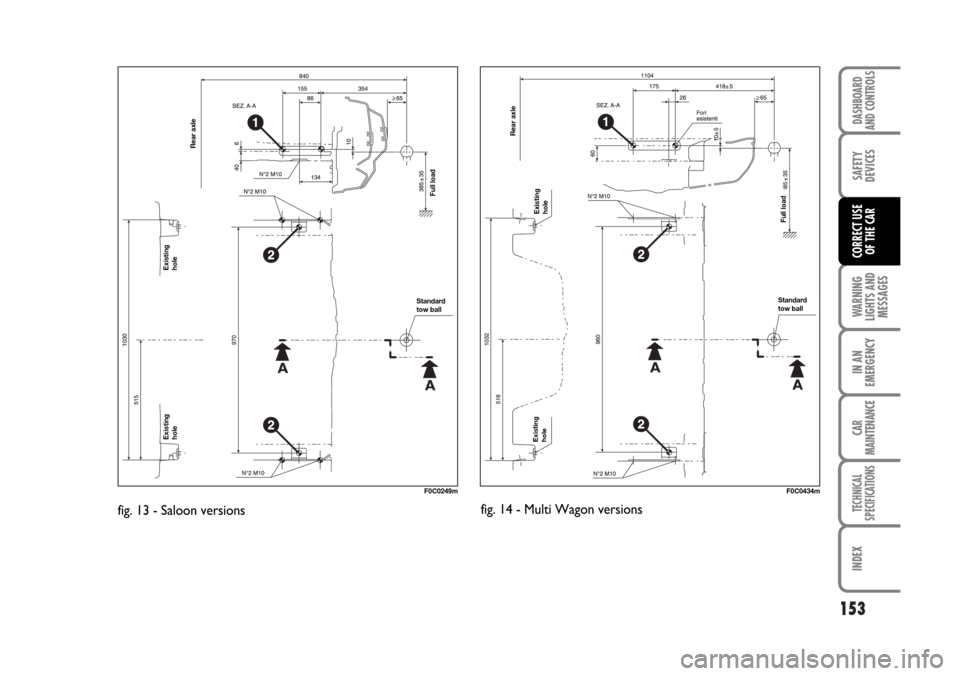
153
WARNING
LIGHTS AND
MESSAGES
IN AN
EMERGENCY
CAR
MAINTENANCE
TECHNICAL
SPECIFICATIONS
INDEX
DASHBOARD
AND CONTROLS
SAFETY
DEVICES
CORRECT USE
OF THE CAR
F0C0249mF0C0434m
Existing
hole
Standard
tow ball
Existing
hole
Existing
hole
Rear axle
Existing
hole
fig. 13 - Saloon versionsfig. 14 - Multi Wagon versions
Full load
Rear axle
Full load
Standard
tow ball